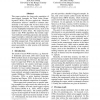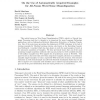150 search results - page 3 / 30 » Four Methods for Supervised Word Sense Disambiguation |
EMNLP
2004
13 years 6 months ago
2004
This paper explores the large-scale acquisition of sense-tagged examples for Word Sense Disambiguation (WSD). We have applied the "WordNet monosemous relatives" method t...
ECAI
2000
Springer
13 years 9 months ago
2000
Springer
Abstract. This paper describes an experimental comparison between two standard supervised learning methods, namely Naive Bayes and Exemplar–basedclassification, on the Word Sens...
ACL
2003
13 years 6 months ago
2003
A central problem of word sense disambiguation (WSD) is the lack of manually sense-tagged data required for supervised learning. In this paper, we evaluate an approach to automati...
COLING
2002
13 years 5 months ago
2002
In this paper, a supervised learning system of word sense disambiguation is presented. It is based on conditional maximum entropy models. This system acquires the linguistic knowl...
JAIR
2008
13 years 5 months ago
2008
This article focuses on Word Sense Disambiguation (WSD), which is a Natural Language Processing task that is thought to be important for many Language Technology applications, suc...


